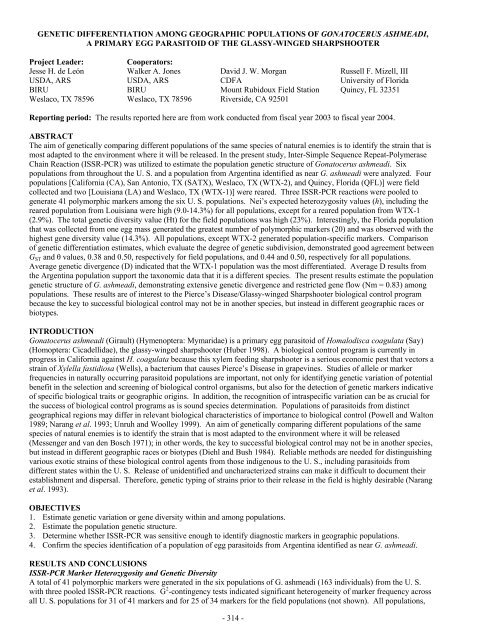Impact Of Host Plant Xylem Fluid On Xylella Fastidiosa Multiplication ...
Impact Of Host Plant Xylem Fluid On Xylella Fastidiosa Multiplication ...
Impact Of Host Plant Xylem Fluid On Xylella Fastidiosa Multiplication ...
Create successful ePaper yourself
Turn your PDF publications into a flip-book with our unique Google optimized e-Paper software.
GENETIC DIFFERENTIATION AMONG GEOGRAPHIC POPULATIONS OF GONATOCERUS ASHMEADI,<br />
A PRIMARY EGG PARASITOID OF THE GLASSY-WINGED SHARPSHOOTER<br />
Project Leader:<br />
Jesse H. de León<br />
USDA, ARS<br />
BIRU<br />
Weslaco, TX 78596<br />
Cooperators:<br />
Walker A. Jones<br />
USDA, ARS<br />
BIRU<br />
Weslaco, TX 78596<br />
David J. W. Morgan<br />
CDFA<br />
Mount Rubidoux Field Station<br />
Riverside, CA 92501<br />
Russell F. Mizell, III<br />
University of Florida<br />
Quincy, FL 32351<br />
Reporting period: The results reported here are from work conducted from fiscal year 2003 to fiscal year 2004.<br />
ABSTRACT<br />
The aim of genetically comparing different populations of the same species of natural enemies is to identify the strain that is<br />
most adapted to the environment where it will be released. In the present study, Inter-Simple Sequence Repeat-Polymerase<br />
Chain Reaction (ISSR-PCR) was utilized to estimate the population genetic structure of Gonatocerus ashmeadi. Six<br />
populations from throughout the U. S. and a population from Argentina identified as near G. ashmeadi were analyzed. Four<br />
populations [California (CA), San Antonio, TX (SATX), Weslaco, TX (WTX-2), and Quincy, Florida (QFL)] were field<br />
collected and two [Louisiana (LA) and Weslaco, TX (WTX-1)] were reared. Three ISSR-PCR reactions were pooled to<br />
generate 41 polymorphic markers among the six U. S. populations. Nei’s expected heterozygosity values (h), including the<br />
reared population from Louisiana were high (9.0-14.3%) for all populations, except for a reared population from WTX-1<br />
(2.9%). The total genetic diversity value (Ht) for the field populations was high (23%). Interestingly, the Florida population<br />
that was collected from one egg mass generated the greatest number of polymorphic markers (20) and was observed with the<br />
highest gene diversity value (14.3%). All populations, except WTX-2 generated population-specific markers. Comparison<br />
of genetic differentiation estimates, which evaluate the degree of genetic subdivision, demonstrated good agreement between<br />
G ST and θ values, 0.38 and 0.50, respectively for field populations, and 0.44 and 0.50, respectively for all populations.<br />
Average genetic divergence (D) indicated that the WTX-1 population was the most differentiated. Average D results from<br />
the Argentina population support the taxonomic data that it is a different species. The present results estimate the population<br />
genetic structure of G. ashmeadi, demonstrating extensive genetic divergence and restricted gene flow (Nm = 0.83) among<br />
populations. These results are of interest to the Pierce’s Disease/Glassy-winged Sharpshooter biological control program<br />
because the key to successful biological control may not be in another species, but instead in different geographic races or<br />
biotypes.<br />
INTRODUCTION<br />
Gonatocerus ashmeadi (Girault) (Hymenoptera: Mymaridae) is a primary egg parasitoid of Homalodisca coagulata (Say)<br />
(Homoptera: Cicadellidae), the glassy-winged sharpshooter (Huber 1998). A biological control program is currently in<br />
progress in California against H. coagulata because this xylem feeding sharpshooter is a serious economic pest that vectors a<br />
strain of <strong>Xylella</strong> fastidiosa (Wells), a bacterium that causes Pierce’s Disease in grapevines. Studies of allele or marker<br />
frequencies in naturally occurring parasitoid populations are important, not only for identifying genetic variation of potential<br />
benefit in the selection and screening of biological control organisms, but also for the detection of genetic markers indicative<br />
of specific biological traits or geographic origins. In addition, the recognition of intraspecific variation can be as crucial for<br />
the success of biological control programs as is sound species determination. Populations of parasitoids from distinct<br />
geographical regions may differ in relevant biological characteristics of importance to biological control (Powell and Walton<br />
1989; Narang et al. 1993; Unruh and Woolley 1999). An aim of genetically comparing different populations of the same<br />
species of natural enemies is to identify the strain that is most adapted to the environment where it will be released<br />
(Messenger and van den Bosch 1971); in other words, the key to successful biological control may not be in another species,<br />
but instead in different geographic races or biotypes (Diehl and Bush 1984). Reliable methods are needed for distinguishing<br />
various exotic strains of these biological control agents from those indigenous to the U. S., including parasitoids from<br />
different states within the U. S. Release of unidentified and uncharacterized strains can make it difficult to document their<br />
establishment and dispersal. Therefore, genetic typing of strains prior to their release in the field is highly desirable (Narang<br />
et al. 1993).<br />
OBJECTIVES<br />
1. Estimate genetic variation or gene diversity within and among populations.<br />
2. Estimate the population genetic structure.<br />
3. Determine whether ISSR-PCR was sensitive enough to identify diagnostic markers in geographic populations.<br />
4. Confirm the species identification of a population of egg parasitoids from Argentina identified as near G. ashmeadi.<br />
RESULTS AND CONCLUSIONS<br />
ISSR-PCR Marker Heterozygosity and Genetic Diversity<br />
A total of 41 polymorphic markers were generated in the six populations of G. ashmeadi (163 individuals) from the U. S.<br />
with three pooled ISSR-PCR reactions. G 2 -contingency tests indicated significant heterogeneity of marker frequency across<br />
all U. S. populations for 31 of 41 markers and for 25 of 34 markers for the field populations (not shown). All populations,<br />
- 314 -











